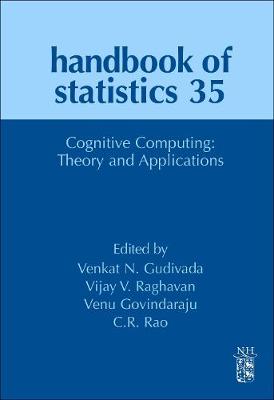Handbook of Statistics
2 primary works • 3 total works
Book 26
Data Mining and Data Visualization focuses on dealing with large-scale data, a field commonly referred to as data mining. The book is divided into three sections. The first deals with an introduction to statistical aspects of data mining and machine learning and includes applications to text analysis, computer intrusion detection, and hiding of information in digital files. The second section focuses on a variety of statistical methodologies that have proven to be effective in data mining applications. These include clustering, classification, multivariate density estimation, tree-based methods, pattern recognition, outlier detection, genetic algorithms, and dimensionality reduction. The third section focuses on data visualization and covers issues of visualization of high-dimensional data, novel graphical techniques with a focus on human factors, interactive graphics, and data visualization using virtual reality. This book represents a thorough cross section of internationally renowned thinkers who are inventing methods for dealing with a new data paradigm.
Book 29
This new handbook contains the most comprehensive account of sample surveys theory and practice to date. It is a second volume on sample surveys, with the goal of updating and extending the sampling volume published as volume 6 of the Handbook of Statistics in 1988. The present handbook is divided into two volumes (29A and 29B), with a total of 41 chapters, covering current developments in almost every aspect of sample surveys, with references to important contributions and available software. It can serve as a self contained guide to researchers and practitioners, with appropriate balance between theory and real life applications.
Each of the two volumes is divided into three parts, with each part preceded by an introduction, summarizing the main developments in the areas covered in that part. Volume 29A deals with methods of sample selection and data processing, with the later including editing and imputation, handling of outliers and measurement errors, and methods of disclosure control. The volume contains also a large variety of applications in specialized areas such as household and business surveys, marketing research, opinion polls and censuses. Volume 29B is concerned with inference, distinguishing between design-based and model-based methods and focusing on specific problems such as small area estimation, analysis of longitudinal data, categorical data analysis and inference on distribution functions. The volume contains also chapters dealing with case-control studies, asymptotic properties of estimators and decision theoretic aspects.
Each of the two volumes is divided into three parts, with each part preceded by an introduction, summarizing the main developments in the areas covered in that part. Volume 29A deals with methods of sample selection and data processing, with the later including editing and imputation, handling of outliers and measurement errors, and methods of disclosure control. The volume contains also a large variety of applications in specialized areas such as household and business surveys, marketing research, opinion polls and censuses. Volume 29B is concerned with inference, distinguishing between design-based and model-based methods and focusing on specific problems such as small area estimation, analysis of longitudinal data, categorical data analysis and inference on distribution functions. The volume contains also chapters dealing with case-control studies, asymptotic properties of estimators and decision theoretic aspects.
Cognitive Computing: Theory and Applications
by Vijay V Raghavan, Venkat N. Gudivada, Venu Govindaraju, and C.R. Rao
Published 9 September 2016
Cognitive Computing: Theory and Applications, written by internationally renowned experts, focuses on cognitive computing and its theory and applications, including the use of cognitive computing to manage renewable energy, the environment, and other scarce resources, machine learning models and algorithms, biometrics, Kernel Based Models for transductive learning, neural networks, graph analytics in cyber security, neural networks, data driven speech recognition, and analytical platforms to study the brain-computer interface.


